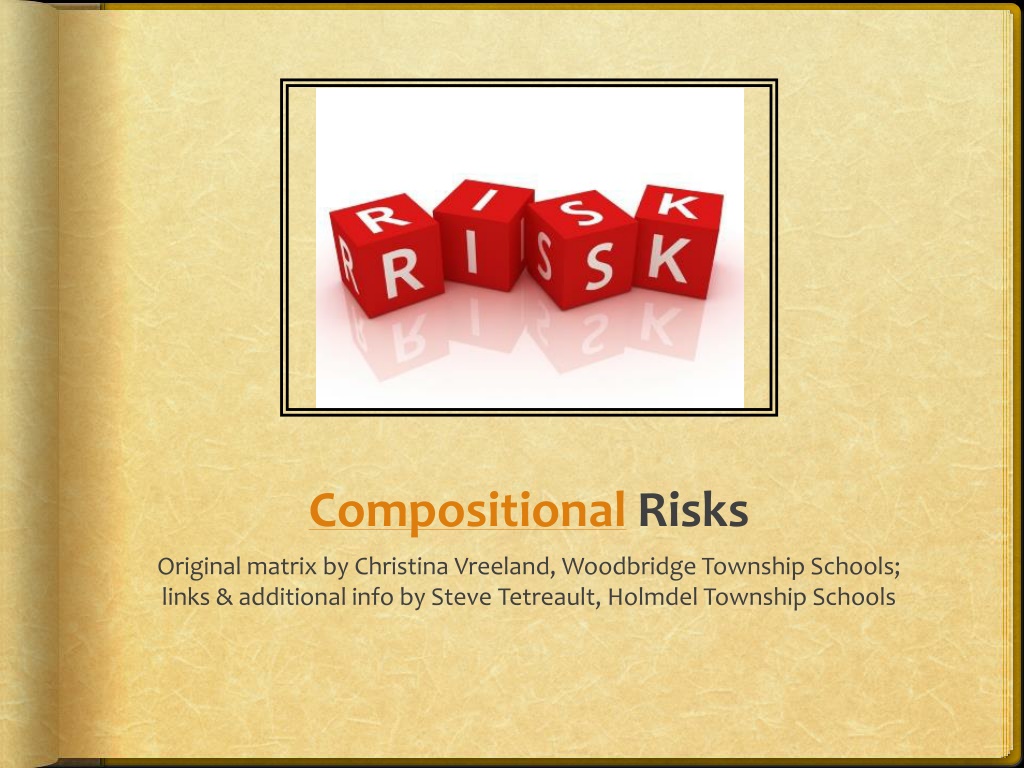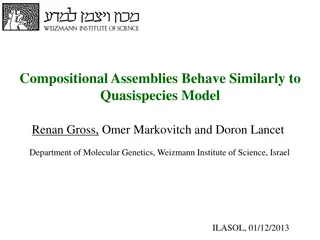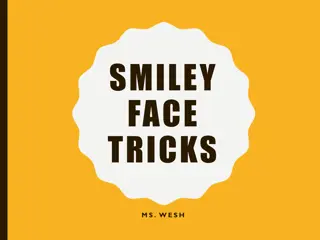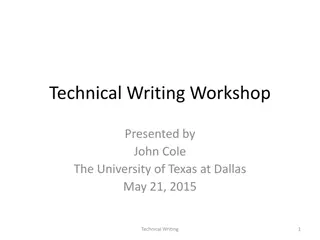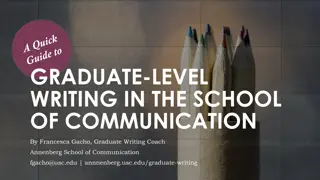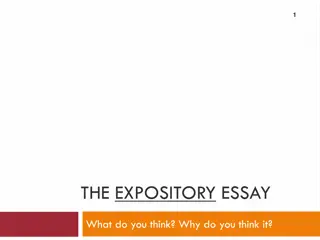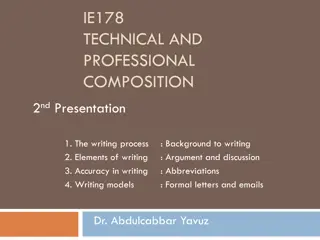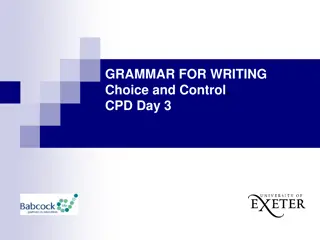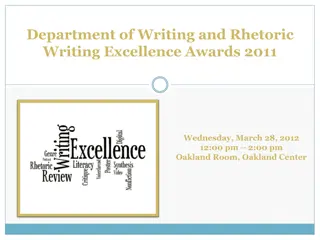Understanding Compositional Risks in Writing
Explore the concept of compositional risk in writing, where authors strive to create engaging and unique content. Learn about the risks writers take to captivate readers, from using voice, repetition, and figurative language to incorporating humor, sarcasm, and surprise elements. Discover how quirkiness, perception, and surprise can elevate your writing, along with the effective use of repetition for impact. Examples illustrate the power of these techniques in creating compelling and memorable writing.
Download Presentation

Please find below an Image/Link to download the presentation.
The content on the website is provided AS IS for your information and personal use only. It may not be sold, licensed, or shared on other websites without obtaining consent from the author. Download presentation by click this link. If you encounter any issues during the download, it is possible that the publisher has removed the file from their server.
E N D
Presentation Transcript
Compositional Risks Original matrix by Christina Vreeland, Woodbridge Township Schools; links & additional info by Steve Tetreault, Holmdel Township Schools
What is compositional risk? "Compositional risk" refers to an attempt by an author (YOU) to do something interesting, engaging, and unusual with his or her writing. Successful compositional risk makes your writing unique in a good way; unsuccessful compositional risk makes it unique in a bad way.
Risks writers take to engage the readers Voice One Word Sentence Repetition Figurative Language Dialogue Addressing the Audience Opening with a question Rhetoric Question
Dont use that tone of voice with me! Risk: Difficult technique to pull off successfully Generally, the idea of "voice" in writing refers to how interesting the writing is to read, how well it grabs and holds the audience.
Dont use that tone of voice with me! Quirkiness - Refers to how individual and different a piece of writing is. Something that is quirky stands out because it is different (hopefully in a good way, but not always). Perception - Refers to the perspective of the writer. A unique perspective or noticing something most people wouldn't provides your writing with a specialness most others cannot match. Surprise - It's difficult to do something completely unexpected in a piece of writing in a way that captures the reader's attention and makes the reader think, in a positive way, about what you have done. Humor - Probably the most difficult part of voice to pull off, because what one person finds funny, another might consider not at all funny, even offensive. However, if you can inject some humor into your writing, your reader will find your work much more interesting. Sarcasm- A careful use of emphasis in your sarcastic writing can go a long way. Consider using italics, bolded words or an occasional all caps word to visually demonstrate your emphasis.
Repetition for effect Writers often repeat specially chosen words or phrases to make a point, to stress certain ideas for the reader.
Example of Repetition for effect Maniac Magee was blind. Sort of. Oh, he could see objects, all right. He could see a flying football or a John McNab fastball better than anybody. He could see Mars Bar s foot sticking out, trying to trip him up as he circled the bases for a home run He could see Mars Bar charging from behind to tackle him, even when he didn t have the football. He could see Mars Bar s bike veering for a nearby puddle to splash water on him. He could see these things, but he couldn t see what they meant (pg. 57; Spinelli, Jerry; Maniac Magee).
One Word Sentence And there was absolutely nothing to eat. Nothing. From Hatchet , by Gary Paulsen
Opening and Closing with a sentence
Motif A writer s style that a recurring subject, theme, idea, etc., especially in a writing. a motif is very similar to an extended metaphor, but it is not as direct in its comparisons; a motif is similar to an allegory, but in reverse - instead of disguising a topic by telling a story about it (as an allegory does), a motif is an idea that happens to fit with a pre- existing idea or situation.
Examples of Motif Edgar Allan Poe s essay
Figurative Language Risk: Using figurative language can be risky if you do not create easily-understood comparisons or descriptions.
Figurative Language Simile : allows the author to create interesting and unusual comparisons that might help the reader see a topic in a new way; BEWARE OVER-USE! Repetition of "like" and "as" can distract the reader. Metaphor - allows the author to create interesting and unusual comparisons that might help the reader see a topic in a new way; is key to the creation of an allegorical point or an extended metaphor Onomatopoeia should be used very sparingly in non-narrative writing; can serve as an effective emphasis for expository writing Personification, is generally only used as part of an extended metaphor or as part of a motif Alliteration - Should be use VERY sparingly in prose writing, but can be extremely effective when emphasizing a point - it will make the audience remember the alliterative phrase very clearly
Examples of Figurative Language Like silent, hungry sharks that swim in the darkness of the sea, the German submarines arrived in the middle of the night (pg. 1; Taylor, Theodore: The Cay). The dream is too long. It slithers and slips and gurgles deeply into midnight pools in which I see my own face looking back. It pounds with a scream that crashes into earth-torn caverns and is drowned; it surges with the babble of voices that splash against my ears; it whispers over words I can t understand (pg. 1; Nixon, Joan Lowery; The Other Side of Dark). Kit went obediently to the door and stepped outside. The white flakes made a queer sort of confusion before her eyes; they brushed her cheeks like tiny flower petals and caught on her eyelashes (pg. 202; Speare, Elizabeth George; The Witch of Blackbird Pond).
Examples of Figurative Language It was a hot day in August. It was so hot, if you stood still too long in the vacant lot, the sun bouncing off a chunk of broken glass or metal could fry a patch on your hide .So hot, if you were packing candy, you had soup in your pocket by two o clock. So hot, the dogs were tripping on their own tongues. And so hot, the fire hydrant at Green and Chestnut was gushing like Niagara Falls (pg. 59; Spinelli, Jerry; Maniac Magee).
Dialogue Risk: Dialogue needs to be punctuated correctly; it also needs to add to the story, not just be there for being there's sake.
Dialogue Dialogue should have a purpose
Dialogue Always put QUOTATION MARKS (") at the beginning of what is being said and after the end of what is being said. "Wow!" Mary shouted, "I can't believe you ate an entire Buick!" "Did you see that?" Jim asked his sister. Michelle whispered, "The answer is 'C' for number four.
Rules for dialogue punctuation Punctuation: The rule of thumb is, "All punctuation goes inside the quotation marks." any punctuation that goes with what is being said goes inside the quotation marks. "Can you believe she hit one hundred home runs yesterday?" "Gee, that's really incredible!" "I know; it makes me wonder if she's using steroids." If it doesn't go with the quotation, it doesn't go inside the quotation marks. Did you just say, "You stink"? I heard you ask him, "Are you done with that pencil?" If you are explaining who said something, you should use a comma. Alyssa shouted, "Wow! That's awesome!" "I can't believe," Chris exclaimed, "that I didn't know this already!" "That's really amazing," Jenna opined. The exception to the comma rule is when the quotation is a question or an exclamation. "Are you sure?" Alex asked. "I don't believe you!" Frank yelled. "You don't have to believe me," Mr. T calmly informed him. "It's still a fact."
Rhetoric Question The word "rhetoric" refers to the use of words and language to communicate clearly and effectively and to influence the thoughts of an audience
Rhetoric Question After posing a rhetorical question, DO NOT refer to the reader; instead, move on with making your point. Rhetorical questions are sometimes most effective when they are used to mislead the audience. Common pitfalls to avoid: DO NOT "talk" to your reader through your rhetorical questions. DO NOT use "you" in your rhetorical questions. DO NOT make your rhetorical questions too simplistic - (as a[n admittedly ridiculous] example, "Should people be encouraged to kick puppies?")
Vivid Imagery Risk: It can be hard to find the balance between "not enough" and "too much Create a mental picture with words.
Vivid Imagery Color: Don't just say "green", be specific about what shade or hue, and feel free to get into some similes and metaphors or other comparisons to help the reader picture it exactly as you see it in your head. Size: As with color, be specific and give easy-to- relate-to comparisons that allow the reader to get a strong mental image of what you're describing. Number: You can use descriptions of the situation and comparisons to help the reader get an idea of the number without actually having to specify a single number
Vivid Imagery Sound: Nowhere is comparison and analogy more important than when discussing sound. Mood/emotion: The word "happy" is rather weak, descriptively; it doesn't really provide much in the way of intensity. A person who finds a penny might be happy, as might a person who wins ten million dollars in the lottery, but they're probably not feeling the same level or degree of that emotion. Many emotive words are similar.
